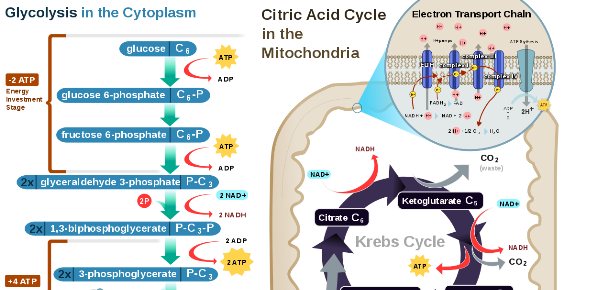Cellular Respiration And Photosynthesis (50:50 Style)

Cellular respiration is a process of making ATP in the mitochondria. Phtosynthesis is a process of making ATPs in the chlorophast. How mush do you know about these 2 things? You will have an A is you are smart.
Questions and Answers
- 1.
In glycolysis, what molecule does glucose break down to?
- A.
Fructose
- B.
Pyruvate
Correct Answer
B. PyruvateExplanation
In glycolysis, glucose breaks down into pyruvate. Glycolysis is the first step in cellular respiration, where glucose is converted into energy. During glycolysis, glucose undergoes a series of enzymatic reactions and is ultimately converted into two molecules of pyruvate. Pyruvate is then further metabolized in the presence of oxygen to produce more energy through the citric acid cycle and oxidative phosphorylation.Rate this question:
-
- 2.
In the photosystem 2, how does electron transfer to the Plastiquenone Qb?
- A.
P6870 to Plastiquenone Qa, Plastiquenone Qa to Plastiquenone Qb
- B.
Chlorophyll to Plastiquenone Qb
Correct Answer
A. P6870 to Plastiquenone Qa, Plastiquenone Qa to Plastiquenone QbExplanation
In photosystem 2, the electron transfer to Plastiquenone Qb occurs in two steps. First, the electron is transferred from P6870 to Plastiquenone Qa. Then, the electron is further transferred from Plastiquenone Qa to Plastiquenone Qb. This sequential transfer of electrons allows for the generation of a proton gradient, which is essential for the production of ATP during photosynthesis.Rate this question:
-
- 3.
Tell on carrier in the chlorophast.
Correct Answer
Plastiquenone Qb
Plastocyanin
Ferredoxin - 4.
In the electron transport chain, what is the electron transferring substances called?
- A.
Enzymes
- B.
Protein complexes
Correct Answer
B. Protein complexesExplanation
The electron transferring substances in the electron transport chain are called protein complexes. These complexes are made up of multiple proteins that work together to transfer electrons from one molecule to another. They play a crucial role in the process of oxidative phosphorylation, where electrons are passed down the chain and ultimately used to generate ATP, the cell's main energy source. Enzymes, on the other hand, are biological catalysts that facilitate chemical reactions but do not directly participate in electron transfer in the electron transport chain.Rate this question:
-
- 5.
What CoA short for?
- A.
Coprotein A
- B.
Coenzyme A
Correct Answer
B. Coenzyme AExplanation
CoA is short for Coenzyme A. Coenzyme A is a vital molecule that plays a crucial role in various metabolic processes in the body. It acts as a carrier molecule, facilitating the transfer of acetyl groups between different enzymes. This transfer is essential for the breakdown of carbohydrates, fats, and proteins, as well as for the synthesis of important molecules like fatty acids and cholesterol. Therefore, Coenzyme A is an important component in energy production and metabolism.Rate this question:
-
Quiz Review Timeline +
Our quizzes are rigorously reviewed, monitored and continuously updated by our expert board to maintain accuracy, relevance, and timeliness.
-
Current Version
-
Mar 20, 2023Quiz Edited by
ProProfs Editorial Team -
Dec 08, 2009Quiz Created by
Quang_vuong0409
Ultimate quiz on Photosynthesis And Cellular Respiration
Ultimate quiz on Photosynthesis And Cellular Respiration
Cellular Respiration and Fermentation Quiz! Trivia
Cellular Respiration and Fermentation Quiz! Trivia
 Back to top
Back to top


